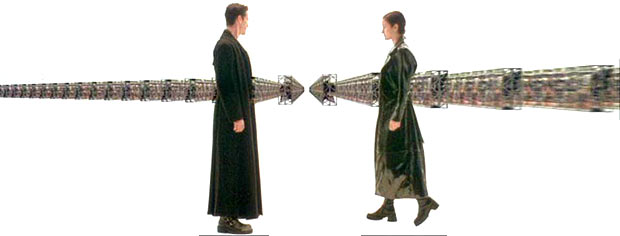(For a description of what a “Looking Outwards” assignment is, please see below.)
Summary of Looking Outwards Assignments
- (Due 1/16) New Media Arts. After foraging widely (consider this list of potential starting points), select three projects in the broadly-scoped field(s) of computational new-media arts and/or design. Choose one project that you admire profoundly (why?), one project that surprised you (why?), and one project that could have been great but disappointed you (why?). (Note: all projects should somehow have involved/required the creation of custom software.)
- (Due 1/21) openFrameworks. Discover and discuss three projects that were made in openFrameworks (OF). As a suggestion: For diversity, choose one project which seems like an important contribution to the field, and one project that seems like a quick but interesting sketch or experiment. To find interesting projects that use OF, you are welcome to start with the following (and also look elsewhere):
- https://vimeo.com/tag:openframeworks (4000+ videos)
- https://www.youtube.com/results?search_query=openFrameworks (2000+ videos)
- https://www.creativeapplications.net/index.php?s=openFrameworks (250+ projects)
You may also find it helpful to check out the work of people like: Andreas Mueller, Caitlin Morris, Chris O’Shea, Daito Manabe, Diederick Huijbers, Elliot Woods, Greg Borenstein, Jessica Rosenkrantz, James George, Joel Gethin Lewis, Josh Nimoy, Karolina Sobecka, Kyle McDonald, Memo Akten, Sofy Yuditskaya, Theo Watson and Emily Gobeille, and Zachary Lieberman, among many others.
- (Due 1/23) ofxAddons. Scan the master list of addons for openFrameworks. Select three that sound interesting to you (why?); explain their possible potential for you. Brainstorm a little.

- (Due 1/30) Information Visualization. Browse various computational visualizations, designs, artworks, and datasets; choose 3 projects to write about. For diversity, consider selecting a balance of subjects, such as: a dataset that you find interesting; a project you find provocative; a project you find well-crafted. To find interesting visualization projects, you are welcome to start from the following links (and also look elsewhere):
As an alternative starting point, you may also consider looking at the work of Aaron Koblin, Amanda Cox, Ben Fry & Fathom, Fernanda Viegas, Jen Lowe, Jer Thorp, Jonathan Harris, Lev Manovich, Lisa Jevbratt, Marcos Weskamp, Martin Wattenberg, Moritz Stefaner, Nicholas Felton, Rachel Binx, Stamen Design, Stephan Thiel & Nand.io, Stephanie Posavec, W. Brad Paley, Wes Grubbs, or CMU’s own Chris Harrison. (Note: Aaron Koblin will be presenting at CMU April 10-11. Student meetings may be possible.)
- (Due 2/06) Generativity & Morphosynthesis. Browse generative work in art, design, architecture, and/or other fields. Choose a phenomenon you find interesting (e.g. cracks, clouds, bubbles, packaging, etc.) and locate some scientific papers on the simulation of this phenomenon. Select at least three things to discuss in your post: for diversity’s sake, at least one should be a method or technique, and at least one other should be a generative (computational) design, artwork or other poetic experience that you find interesting or aesthetic.
- (Due 2/25) Interactive Art, Interaction Design, Speculative Interactions. From blogs and any other sources, identify and discuss three projects which each present a new form of interactivity and/or real-time processing that you find interesting. Try to identify forms of processing and/or response that beyond solo screen experiences (though those are ok too).
- (Due 2/27) Computer Vision. Details TBA.
- (Due 4/01) Capstone Research. Find prior work which is pertinent to the final project you would like to develop. How have others addressed similar questions as yourself? What work has inspired you? What opportunities were overlooked by others? Identify at least three relevant projects. Evaluate them aesthetically, technically, culturally.
What is a “Looking Outwards” Assignment?
On at least 8 occasions this semester, you will be asked to “look outwards” — to browse various blogs and feeds in order to deepen your knowledge of the field, and familiarize yourself with the current state of the art. You will then be expected to report on your findings, as described below — hopefully, with a critical perspective. Often, the “Looking Outwards” assignments will be thematically oriented. There is no restriction on the sources of information you may use for a “Looking Outwards” assignment — for example, you are welcome to use the library, especially to learn about older works which may not be well-documented on the Internet.
A “Looking-Outwards Assignment” is one blog post containing 3 discoveries.
The emphasis is on “discoveries” — browse blogs and other sources to encounter and report on three projects that you haven’t seen before. For this course, it may be most appropriate to select projects that are made by individuals or small teams, rather than large companies. In a blog post, embed relevant images or video of each project, and write a paragraph (~150 words) about each project, in which you:
- Explain the project in just a sentence or two;
- Explain what inspires you about the project (i.e. what you find interesting or admirable);
- Critique the project: describe how could it have been more effective; discuss some of the other possibilities that it suggests, or opportunities it missed; explain what you think they got right, and how they got it right.
- Dig up the ‘deep background’, and compare the project with related work or prior art, if appropriate. What sources inspired the creator this project?
- Please be sure to tag your blog post with our WordPress “category”, Looking-Outwards.
- Name your blog post(s) consistently, with the title YourName-LookingOutwards-1, etc.